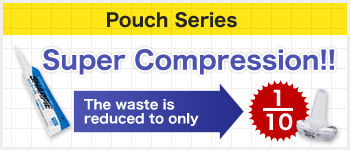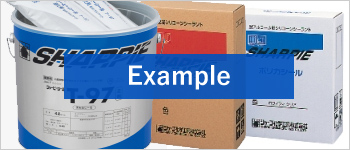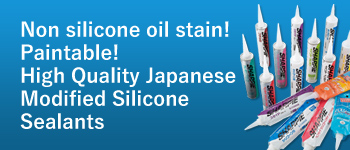Frequently Asked Questions
MENU
- Sealants and Fillers
- Sharp Chemical Products
- Construction
- Adhesives
- QWhat's the difference between caulking materials and sealant?
- ANowadays, caulk refers to oil based caulk.
Sealant used to be called caulk. Even now, some people think sealants are a type of caulk .
- QWhat's the difference between regular silicone and modified silicone?
- AIn comparison with Silicone, the heat-resistance and water-resistance of Modified are not so good. However its advantages are paintable, less pollution, rust proof. It is all-featured sealant.
Compared to regular silicone, it is weaker in heat-resistance an water resistance. Its advantages are its paintability, producing less pollution, being rustproof, etc. It is a general purpose sealant.
- QAre modified silicone sealant and silicone sealant related to each other?
- A
No.
Similar name but different chemical compositions. So MS sealant is totally different from silicone sealant.
- QWhat does the symbol F★★★★ means for sealant materials?
- AF★★★★ is the symbol referring to the lowest exudation of formaldehyde, or lowest leakage of formaldehyde. Even though the current Japanese Building Law does not require the symbol, we members of JSIA are displaying this symbol. Formaldehyde is a possible component in building materials that is believed to cause Sick House Syndrome, but there are other possible candidates such as toluene, xylene solvent VOC (volatile organic compound). For more information, check out our homepage.
- QDo sealant materials produce formalin?
- AOur company endeavors to develop minimize the use of formalin up to the building law’s standards. We will always do our best to minimize indoor pollution.
The formalin detection techniques we use are able to detect more than techniques used in previous years. Note that Silicone, Modified Silicone, and Urethane sealants do not produce formalin.
- QDo you have sealant with high ozone resistant quality?
- A
Silicone-based sealants have the highest ozone resistance. It hardly deteriorates in a normal environment.However, deterioration may progress in a highly acidic environment. Therefore, deterioration will progress in acid rain and hot spring areas.Even so, it can be said that there is less deterioration than other urethane and modified silicone products.
- QWhat is silicone oil pollution?
- ASilicone oil generated from silicone-based sealants adsorbs dirt in the air and stains the surface.Dirt can be removed by cleaning, but it will occur repeatedly unless the silicone-based sealant is removed.
- QWhat is a 2-sided adhesion?
- AIt's a method that is necessary for maintaining the proper silicone performance. 2-sided adhesion is applied to the moving joints while the three-sided adhesion is applied to non-moving joints.The insertion of the back up rod ensures 2-sided adhesion and the proper tensile strength of the joint.
- QHow to apply silicone for moving-joints and non-moving joints?
- AThe joint parts expand or contract when subjected to changes in temperature, coating materials vibrate with the joint parts are called moving-parts coating, and no tolerance on joint parts are called non-moving coating.2-sided adhesion is applied to the moving joints while the three-sided adhesion is applied to non-moving joints.The insertion of the back up rod ensures 2-sided adhesion and the proper tensile strength of the joint.
- QWhat is stress relaxation sealing force?
- ASealing materials are viscoelastic in nature and the stored energy decreases over time. This decrease of the stored energy (seen as contact sealing force) over time is known as stress relaxation. In other words, stress relaxation is the change in stress with time when the sealant is held under constant strain.High stress relaxation sealing force sealing materials are often used on ceramic siding materials.
- QWhat is surface plasticiser layer contamination(bleeding)?
- ASurface bleeding is a phenomenon caused by the formation of a plasticiser layer on the surface (bleeding). When plasticizer in the sealant leaks out of the sealant, and the surface becomes sticky during aging, causing a surface contamination. Bleeding prevention sealants are called Non-Bleed(NB) Type sealants.
- QCan I paint over silicone based sealant?
- ANO,paint doesn't adhere to silicone-based sealants.Other things like adhesives,double-sided tapes,etc.are also not applicable.
- QWhat's elastomeric adhesives?
- Aelastomeric adhesives are highly elastic.The ordinary adhesives become very hard and brittle and lack of elasticity after applied,and cause crackings of the adhesive layer when moving.However, elastomeric adhesives have stress relaxation force which can reduce the risk of cracking.
- QHow long is the service life of a sealant?
- AThe service life depends on many different factors.
The supervisor of technical surveys in the Ministry of Construction explains the service life of sealants in the book “Techniques of Improving Durability of Construction Waterproofing”. The following is a list of factors affective a sealant’s service life:
(1) Coefficient of the compatibility between adherent and substrate
(2) Coefficient of colour and direction
(3) Coefficient of surface adhesion difficulty
(4) Coefficient of the degree of difficulty
(5) Coefficient of the worker’s skill
(6) Coefficient of UV radiation (differentiated by different regions and application location)
(7) Coefficient of preservation and maintenance
Because many of these factors are too complex to be analyzed quantitatively, it is difficult to determine the exact service life of a particular sealant.
- QWhat is the hardness of the sealing material after it fully cures?
- AThe hardness varies sealant to sealant. For most sealants, the hardness is close to that of rubber. Epoxy and urethane substances are have higher hardness and there are harder when fully cured.
- QWhat are the JIS standards of sealing material fatigue resistance durability against weathering and joint movement ?
- AThe explanation for silicone durability is explained in JIS A5758-2004
The meaning of 7020 is that at 70˚C the joint experiences 20% compression, and at –10˚C the joint experiences 20˚C expansion. By the same token, 8020 means that at 80˚C, 20% compression, -10˚C, 20% expansion. Even at these extremes, the sealants perform their duties.
Currently, sealant for general construction meet he 7020 standard, while all others meet the 8020 standard. The sealant used for glass goes by a different standard.
- QHow heat resistant is silicone based sealant materials?
- AOur normal Silicone series can resist about 150˚C of instantaneous heat, and is able to sustain 120˚C.
We also provide a special silicone with high-temperature resistance (can resist 28O˚C). Our Sharpie Modified Series does not have very high-temperature resistance. The series can sustain 80˚C, or temporary bursts of 130˚C.
The products’ heat-resistance will weaker as it is exposed to high temperatures.
- QTwo-component sealing material is usually fast drying. Can I adjust the curing time by changing the mixing ratio?
- AThe mixing ratio of the two-component sealing material is determined after confirming the performance of the sealing material.Therefore, if the mixing ratio is changed and adjusted, the original performance (durability, adhesiveness, weather resistance) will be affected, and problems such as peeling, deterioration, and color difference may occur.If you want to accelerate or delay curing, we also offer materials to slow or accelerate the curing time and maintain the performance. Please feel free to contact us for more information.
- QI want to seal a low temperature place like a refrigerated warehouse. Is it ok to seal at a low temperature?
- AThe drying time listed in the Sharp Chemical Industry catalog is measured at a temperature of 23 ° C.The curing time of the sealant will be affected under the temperature of 10 ° C or lower, therefore the curing time will be significantly delayed or will not be cured if the construction is performed in an environment of 5 ° C or lower.Please raise the temperature inside the warehouse before starting construction.
- QWhat is SDS and why is it important? Where to download Sharpchem products SDS?
- AA safety data sheet (SDS), previously called a Material Safety Data Sheet (MSDS), is a document that provides information on the properties of hazardous chemicals, how they affect health and safety in the workplace and on how to manage the hazardous chemicals in the workplace.Sealants and primers are also chemical products, so be sure to check and follow the SDS(MSDS) for proper handling.You can download the SDS(MSDS) of our products from our website: http://www.sharpchem.co.jp/download/
- QWhy is primer needed?
- AA primer is a paint; a coat of paint that is applied directly to the bare substrate. Theword ‘primer’ means ‘first’ and in this case it is the first coat to be applied to the timber,steel or other surface to be coated. The main functions of primers are to provide excellent adhesion to the substrate for the new paint system and help to prevent stains and tannins from bleeding through into the topcoats and ruining the finished job.
- QIs it possible that once cured sealants become soft again?
- A
Sealants rarely soften under normal conditions, but appear to be able to soften under harsh environment:
・ Chemical swell due to contact with oils and chemicals
・ Decomposition by ultraviolet rays
・ Chemical decomposition by acid and alkali
・ Oxidative deterioration due to oxygen and oxidizing agents
- QWhy is the time between primer and paint necessary?
- AWaiting time between primer and paint is very important.After applying primer it takes time to form a protective skin of the substrate,and ensure the long-lasting quality.Therefore I advice you to always give primer a cure time.
- QWhat will happen if movement happens during curing?
- ASurface cracking and cohesive failure will occur when movement happens during curing time.Since the one-component sealant starts to cure from the surface, it takes longer time to cure than two-component sealant completely, making it more fragile to movement.
- QI know that modified silicone and urethane are always used for sidings, which one do you recommend?
- ACompared to modified silicone, urethane sealants are generally weak UV resistant.Urethane sealants from Sharpchem are not used for new siding construction. The one that can be used for repairing purpose is Paint Urethane,When using this product, please always apply a topcoat to it.However, these days, urethane-based sealing materials with excellent weather resistance are also sold by other manufacturers. The superiority or inferiority is different depending on the product.Therefore, please check the usage method recommended by each manufacturer and check the siding substrate material before applying.
- QIs SHARPIE Oil Based sealing materials a solvent-based caulking?
- ANo, it is a sealing material made from natural plant linseed oil. It dries only on the surface but keeps soft inside, lacking elasticity but has a high waterproof performance because it can follow any movement of cracks.
- QHow to prevent birds from eating silicon caulkings?
- AIt happens everywhere. We don't know why they do this - crows and rooks are better known for this kind of behaviour but usually attack rubber seals and wiper blades etc.A simple solution is covering the surface with an aluminium or plastic strip which is applied over the sealant. These strips should be bonded on one side of the substrate next to the joint to enable the joint underneath to function without restrictions.
- QWhy it doesn't dry after urethane be applied over silicone?
- ASilicone will produce an oxime gas by-product. This gas reacts with urethane based sealants that causes cure inhibition.
As a basic rule, do not use these two sealants at the same time. If unavoidable, use modified silicone.
- QWhat are the differences between Oxime-Cured Type and Oxime Type in the Silicone series products?
- AOxime-Cure and Oxime Types have the same meaning. In general, silicone based sealants produce an oxime gas. This gas is hardened when it is released, resulting in its two names, Oxime-Cured and Oxime. Other Silicone sealants types are an alcohol type and an acetic acid type—they are not usually used domestically. The alcohol type does not make cracks in plastic and also causes zero rusting in copper, and has been recently increasing in demand for these properties.
We sell Oxime type sealants by the name of Polyca Seal.
- QIs the Modified Silicone an oil based or water based sealant?
- AThe answer to this question is both easy and at the same time difficult. Our modified sealants can be said oil based because they are made from natural plant linseed oil.But if you are asking are they solvent-based the answer will be no.Our Butyl series products are solvent based sealants, modified sealants are resin based sealants and acrylic serious are water based sealants.
























